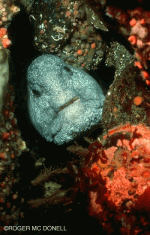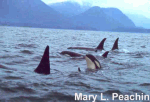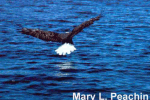by Yvette Cardozo with photography by Yvette Cardozo, Alan Murray, Roger McDonnell and Mary L. Peachin
Feb 2002, Vol. 6 No. 4
 Drifting in the current of the emerald green water at a depth of 80 feet, John Fulop, was watching the swaying tentacles of a colorful anemone when suddenly a Stellar sea lion grabbed his fin. Quickly, he tucked his knees to somersault and the two tumbled in a joyful game of underwater tag.
Drifting in the current of the emerald green water at a depth of 80 feet, John Fulop, was watching the swaying tentacles of a colorful anemone when suddenly a Stellar sea lion grabbed his fin. Quickly, he tucked his knees to somersault and the two tumbled in a joyful game of underwater tag.
John and the rest of us were diving the Inside Passage between Vancouver, British Columbia, and southeast Alaska on the 116-foot Nautilus Explorer. The custom built 26 passenger, 116-foot expedition dive boat has a hot tub, carries six kayaks, a canoe, two rowboats, an inflatable and offers enough shore trips to keep non-divers busy. Dives are made from a 38-foot aluminum skiff. Water temperatures average low 40s, definitely dry suit conditions.
 Thinking about how unique the trip is, boat owner Mike Lever, mused, “of the million cruise ship passengers that take this voyage each summer, I doubt a single person has seen the depths of this Passage.
Thinking about how unique the trip is, boat owner Mike Lever, mused, “of the million cruise ship passengers that take this voyage each summer, I doubt a single person has seen the depths of this Passage.
Take our experience at South Sawyer Glacier. As our dive boat idled 300 yards from its frozen face, we admired its towering wall of glycerin-like blue ice. Suddenly the glacier calved, shedding a huge vertical slab of ice that crumbled into the water seemingly in slow motion. When it hit the water it created a huge wave that thundered like a blast of dynamite.
 After watching a bit, we pulled on our drysuits and slipped into the frigid water. Swimming over to more distant calved ice, we scrambled on top of the icebergs then slid, floundered and flopped back into the water. Above water, the ice was rough and eroded, while underneath, it was smooth, slick and milky white. We spent an hour there playing and snapping pictures.
After watching a bit, we pulled on our drysuits and slipped into the frigid water. Swimming over to more distant calved ice, we scrambled on top of the icebergs then slid, floundered and flopped back into the water. Above water, the ice was rough and eroded, while underneath, it was smooth, slick and milky white. We spent an hour there playing and snapping pictures.
Earlier in the trip, we had stopped at the remote, rustic village of Point Baker (population 21) which from a distance appeared like a notch along the Pacific coastline. But inside (accessible only by boat or seaplane), there is a sagging dock and a dozen or so rustic cabins. Along the waterfront, residents were gutting fish, stoking cabin fires, or just counting eagles as they soared on updrafts in the wind. We peeked in at the local bar, where visitors had papered dollar bills to the back wall. And before we left, we paddled our kayaks across the mirror-smooth water of a tiny side inlet where we saw a graveyard of small fishing boats.
 After the glacier swim, we cruised past Petersburg, a small Alaskan village with tidy wood buildings and truly, and an abundance of bald eagles. Two dozen crowded a single tree. Others soared aloft, some carrying salmon in their beaks. Others sat on telephone poles, rooftops, or backyard fences.
After the glacier swim, we cruised past Petersburg, a small Alaskan village with tidy wood buildings and truly, and an abundance of bald eagles. Two dozen crowded a single tree. Others soared aloft, some carrying salmon in their beaks. Others sat on telephone poles, rooftops, or backyard fences.
We enjoyed frequent sightings of humpback whales. We would spot a spume of spray, which was followed by the barnacle-encrusted back. The sight of the black and white tail finning skywards, frequently framed by distant glaciers, was the signal that the whale was sounding into the depths.
 Topside sights on our two-week adventure included Baranof Hot Springs, tucked beside a roaring river and surrounded by old growth cedars and firs. Another day we visited the abandoned village of Butedale where buildings lean at crazy angles as they slowly deteriorate and crumble into the water. In Canada’s Queen Charlotte Islands, we hiked through a centuries-old village where carpets of moss covered ancient First Nations long house pits and weathered totems.
Topside sights on our two-week adventure included Baranof Hot Springs, tucked beside a roaring river and surrounded by old growth cedars and firs. Another day we visited the abandoned village of Butedale where buildings lean at crazy angles as they slowly deteriorate and crumble into the water. In Canada’s Queen Charlotte Islands, we hiked through a centuries-old village where carpets of moss covered ancient First Nations long house pits and weathered totems.
 As the days passed, we sailed through an incredibly textured landscape, one of rugged pillars of rock, firs and cedars. The tree trunks were bent from years of savage winds and their twisted roots only added to the beauty.
As the days passed, we sailed through an incredibly textured landscape, one of rugged pillars of rock, firs and cedars. The tree trunks were bent from years of savage winds and their twisted roots only added to the beauty.
During the trip, we made 28 dives. At a site named Adam’s Wall along the British Columbia coast, we discovered a reef covered by a forest of metridiums … vast clumps of animals that look like stalks of snow-white broccoli. At a depth of 40 feet, crevices in the wall led into narrow tunnels covered with neon pink anemones the size of dinner plates, patches of strawberry anemones that look like translucent hair and algae that draped the rocks like lace. The vegetation was so lush, we couldn’t find a bare spot to rest a finger.
 We also dived on some ship wrecks, one of them a 180 foot fishing boat resting vertically against a steep bank in more than 100 feet of water. It was like exploring a miniature Titanic … pitch-black water, ghostly portholes, decks coated in hairy algae, its wheelhouse with all the gear intact.
We also dived on some ship wrecks, one of them a 180 foot fishing boat resting vertically against a steep bank in more than 100 feet of water. It was like exploring a miniature Titanic … pitch-black water, ghostly portholes, decks coated in hairy algae, its wheelhouse with all the gear intact.
But usually our favorite dives were the ones with critters. Near Dillon Rock, off the northern tip of Vancouver Island, we discovered colonies of wolf eels. A dozen huddled under one rock, their jaws and sharp teeth opening and closing in the swift current.
 Averaging about six feet with blue-gray, blunted heads and squashed faces, the eels were so ugly, they were adorable. A large male, wiggled out of a crevice to observe my dive light. Apparently intrigued by its reflection in the eight inch curved dome port of my camera housing, he ventured out of his hole and settled into the crook of my elbow. I gently stroked the top of his head as he closed his eyes, seeming to relax in sheer bliss. Then he slowly slithered between my legs back into his crevice.
Averaging about six feet with blue-gray, blunted heads and squashed faces, the eels were so ugly, they were adorable. A large male, wiggled out of a crevice to observe my dive light. Apparently intrigued by its reflection in the eight inch curved dome port of my camera housing, he ventured out of his hole and settled into the crook of my elbow. I gently stroked the top of his head as he closed his eyes, seeming to relax in sheer bliss. Then he slowly slithered between my legs back into his crevice.
 The beauty of the Inside Passage is spectacular and to be able to view its underwater depths is a unique opportunity experienced by few.
The beauty of the Inside Passage is spectacular and to be able to view its underwater depths is a unique opportunity experienced by few.
For further information: The Nautilus Explorer offers 10 or 15-day trips during the summer months from Vancouver to Alaska or the Queen Charlotte Islands. Trips range in price from $1,995-$2995.00 USD Some of the journeys focus on photography taught by Optiquatics, other trips focus on marine biology.
Lever Diving (888)4 DIVE BC or e-mail mike@divebc.com. or go to www.nautilusexplorer.com.
Some of the Nautilus Explorer trips include an Optiquatics underwater photo course. This course includes instruction on a simple “point and shoot” underwater camera as well as sophisticated cameras with housings using a variety of lenses and strobes. The course adds $50 per day to the standard trip price and covers photo gear, film and instruction.
Optiquatics (310)457-3403 or go to www.optiquatics.com.
Other Alaska dive operators: Ketchikanâ’s Wind & Water Charters go to www.ktn.net/windwater Sitkaâ’s Clay’s Dive Shop go to www.divingalaska.com Juneauâ’s Channel Dive Center go to www.channeldive.com.
Mary L. Peachin is a Tucson-based adventure travel writer and photographer. Read about her adventures at test.peachin.com or e-mail her at mary@peachin.com
